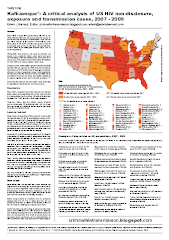The trial of Clato Mabior, the Sudanese migrant found guilty on six counts of criminal HIV exposure in Winnipeg earlier this month, was exceptional in a country where trials for criminal HIV exposure and transmission take place on an almost weekly basis.
First, the Mabior case is difficult for those of us who want to challenge criminal prosecutions for HIV exposure or transmission due to the nature of Mr Mabior's other offences. It has resulted in a strong-worded editorial in the Winnipeg Free Press (see below) which suggests that the Canadian public cares little about understanding important issues such as the effect of treatment on transmission risk, or why disclosure is not necessarily the best way of protecting oneself and others from HIV.
Second, and even more important, the transcript of the verdict by Queen's Bench Justice Joan McKelvey, who presided over the trial is the first I’ve seen to seriously consider up-to-date science on the effect of HIV treatment on the risks of HIV exposure, as well as deal with the vexing issue of residual risks with condom use.All HIV infected persons are told of their obligations to sex partners. If they break the rules, they should be subject to a health order and police intervention -- second chances merely put innocent persons at risk. Mabior's warped sense of obligation and desperate attempt to rationalize his depraved conduct indicate a need to balance risk with the swift and heavy hammer of police action when trust is breached.
The defence argued that Mabior’s state of mind was that he did not believe he was infectious, and submitted the recent Swiss statement on the effect of treatment on infectiousness. However, expert testimony from Dr John Smith, who concluded that Mr Mabior may have been uninfectious for some of the time, also stressed that condoms were only 80% reliable. (An excellent review of condom effectiveness by Michael Carter of NAM, can be found here).
The Crown argued that the CDC and WHO disagreed with the Swiss, and this had the effect of persuading Justice McKelvey that the Swiss were probably wrong, that the Swiss statement only applied to monogamous couples with disclosure.
[81] The evidence of the accused's undetectable viral load and its relationship to HIV transmission was also considered by the Crown. The Crown submitted that there was no evidence to suggest that a significant risk of serious bodily harm did not exist when viral loads were undetectable. There was argued to be a continuing risk that HIV could be passed through sexual intercourse in such circumstances. The issue was not related to a percentage of risk, but instead concerned the potential consequences of transmission, which were described as lethal. If there was any chance of transmission, there was an intolerable risk. The Thornton case was argued to evidence such a finding.
Justice McKelvey concluded the following:
[101] The statements of the CDC and WHO express very well the continuing risks of the transmission of this disease.
[104] I am also persuaded that endangerment of life has been proven in those circumstances where protection was utilized. This finding is supported by the evidence of Dr. Smith that condoms are considered to be only 80% reliable.
[105] This finding of endangerment of life includes those complainants who were exposed while the accused's viral load was considered to be low, suppressed or undetectable. I have found the medical and scientific evidence to be very persuasive that even with an undetectable viral load, there remains a risk of transmission of HIV with resultant endangerment of life. This is particularly so given the medical evidence that other influences or factors such as STDs or the use of female contraception can affect or “spike” a viral load.
[106] There was a continuing risk that HIV could be passed upon sexual intercourse in all of the circumstances. I find from the evidence that there was endangerment to life for each of the complainants in this case.
She also noted that the Swiss statement – and the publicity about it – happened three years after the events for which Mr Mabior was on trial.
Worryingly, she also found that since that there is residual risk even when condoms are used, due to their 20% 'failure' rate, a "significant risk of serious bodily harm existed".
[116] I am not prepared to follow the decision in Edwards with respect to the issue of protected intercourse based upon the medical evidence which was presented in this case and the “reliability” factor related to condom use. In this context, it is important to recall the evidence of Dr. Smith which stated that condoms are only 80% reliable and constitute an 80% reduction in HIV incidence. (Report, p. 6). Further, cases such as Thornton have demonstrated that a 99.3% screening safety rate was still considered to be too significant a risk in those circumstances. I am persuaded that in those circumstances where protection was used and the accused was regarded as infectious by the medical evidence, that a significant risk of serious bodily harm existed.
However, she did accept that "the combination of an undetectable viral load and the use of a condom would serve to reduce the risk below what would be considered a significant risk of serious bodily harm."
I have made the 65 page transcript of Justice McKelvey's ruling available to download as a pdf document (484 KB) in full from my website: here.
(Click here for a page refresh with all postings on the Clabior case)
HIV precedent
Winnipeg Free Press
July 17, 2008There is a telling element in the case of an HIV-infected Winnipegger convicted this week of having unprotected sex with six young women. His defence rested on his contention that medical science shows the risk of passing on HIV during sex was so low that he had no responsibility to tell his partners he was carrying the AIDS virus.Clato Lual Mabior, a man who preyed upon vulnerable young women and girls, is an unlikely authority on the relative risks of transmitting HIV. One victim testified that she was raped and that intercourse had been anal and unprotected, much riskier than protected vaginal sex. As well, the health status of the sex partner can change those odds dramatically: A woman with a sexually transmitted disease is much more susceptible to HIV. Mabior had multiple sex partners, increasing risk further.
None of this, however, is germane to the charges he faced. Anyone who does not inform a sex partner he or she has HIV can be found guilty of aggravated sexual assault. Mabior is facing deportation to his native Sudan, after he serves his sentence here. But that can be little solace to his victims, who faced or face years of uncertainty over their own health. It is little comfort to the general public to know that although Mabior was in contact with public health officials who repeatedly warned him of his obligations to his sex partners, he abandoned any sense of responsibility and decency for his own pleasure. He was not served with a public health order, under which he could have been detained, until police charged him with sexual assault. At that point, the Winnipeg Regional Health Authority took the unprecedented step of issuing a public notice, identifying the fact he was HIV-positive.
Mabior, like another man before the courts on similar charges, was given the benefit of doubt by public health authorities, tasked with counselling and monitoring those with HIV and AIDS. The latter man was given repeated warnings, despite officials learning he was having unprotected sex. Understandably, a public health worker treads a fine line as health practitioner and public watchdog, but the cases indicate the pendulum must swing further into the realm of public interest.
All HIV infected persons are told of their obligations to sex partners. If they break the rules, they should be subject to a health order and police intervention -- second chances merely put innocent persons at risk. Mabior's warped sense of obligation and desperate attempt to rationalize his depraved conduct indicate a need to balance risk with the swift and heavy hammer of police action when trust is breached.








0 comments:
Post a Comment